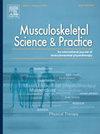Manual therapy and neck-specific exercise are equally effective for treating non-specific neck pain but only when exercise adherence is maximised: A randomised controlled trial
IF 2.2
3区 医学
Q1 REHABILITATION
引用次数: 0
Abstract
Objective
To assess the effectiveness of manual therapy versus a progressive, tailored neck-specific exercise program with high adherence for treating non-specific chronic neck pain (NSNP) and to examine the relationship between exercise adherence and treatment outcome.
Design
Single-blind, parallel, randomized clinical trial with two treatment arms, adhering to CONSORT guidelines.
Methods
65 NSNP participants were randomly allocated to manual therapy or exercise. They received four treatment sessions of either manual therapy or neck-specific exercise, once a week for four weeks. Outcomes measured at baseline, two weeks, four weeks, and 12 weeks post-treatment included pain intensity, disability, patient-perceived improvement, quality of life, kinesiophobia and the craniocervical flexion test (CCFT) performance. In addition to evaluating each individual outcome, patients were categorized into either responders or non-responders according to pain intensity, disability and patient-perceived improvement. Exercise adherence was recorded.
Results
There were no differences between groups in individual outcomes. Treatment outcome in the exercise group was associated with exercise adherence. Patients receiving manual therapy were more likely to be classified as responders than those receiving exercise at all measured time points (odds ratio, 2 weeks: 0.14; 95 % CI: 0.02–0.79; treatment completion: 0.31; 95 % CI: 0.12–0.82; 12 weeks after treatment completion: 0.19; 95 % CI: 0.05–0.65), however these differences were no longer present when only patients whose exercise adherence was ≥95 % were analysed. Exercise was more effective than manual therapy in improving CCFT performance but only if patients with ≥95 % adherence were considered.
Conclusion
A four-week intervention of manual therapy was more effective than exercise, however when exercise adherence was ≥95 %, the interventions were equally effective. Manual therapy may only be superior to specific-exercise when high exercise adherence cannot be assured.
一项随机对照试验:手工疗法和颈部特异性运动对治疗非特异性颈部疼痛同样有效,但前提是运动坚持程度达到最高
目的评估手工疗法与渐进式高依从性颈部特异性运动方案治疗非特异性慢性颈部疼痛(NSNP)的有效性,并研究运动依从性与治疗结果之间的关系。设计:单盲、平行、随机临床试验,两个治疗组,遵循CONSORT指南。方法65例NSNP患者随机分为手工治疗组和运动组。他们接受了四个疗程的治疗,要么是手工治疗,要么是颈部特定运动,每周一次,持续四周。治疗后基线、2周、4周和12周测量的结果包括疼痛强度、残疾、患者感知改善、生活质量、运动恐惧症和颅颈屈曲试验(CCFT)表现。除了评估每个个体结果外,根据疼痛强度、残疾和患者感知的改善情况,将患者分为有反应者或无反应者。记录运动坚持情况。结果两组患者个体预后无差异。运动组的治疗结果与运动依从性有关。在所有测量时间点,接受手工治疗的患者比接受运动治疗的患者更有可能被归类为反应者(优势比,2周:0.14;95% ci: 0.02-0.79;治疗完成度:0.31;95% ci: 0.12-0.82;治疗完成后12周:0.19;95% CI: 0.05-0.65),然而,当仅分析运动依从性≥95%的患者时,这些差异不再存在。运动在改善CCFT表现方面比手工治疗更有效,但仅在患者依从性≥95%的情况下考虑。结论4周的手工治疗干预比运动治疗更有效,但当运动依从性≥95%时,干预效果相同。手工疗法可能只优于特定的运动,当高运动坚持不能保证。
本文章由计算机程序翻译,如有差异,请以英文原文为准。
求助全文
约1分钟内获得全文
求助全文
来源期刊

Musculoskeletal Science and Practice
Health Professions-Physical Therapy, Sports Therapy and Rehabilitation
CiteScore
4.10
自引率
8.70%
发文量
152
审稿时长
48 days
期刊介绍:
Musculoskeletal Science & Practice, international journal of musculoskeletal physiotherapy, is a peer-reviewed international journal (previously Manual Therapy), publishing high quality original research, review and Masterclass articles that contribute to improving the clinical understanding of appropriate care processes for musculoskeletal disorders. The journal publishes articles that influence or add to the body of evidence on diagnostic and therapeutic processes, patient centered care, guidelines for musculoskeletal therapeutics and theoretical models that support developments in assessment, diagnosis, clinical reasoning and interventions.
 求助内容:
求助内容: 应助结果提醒方式:
应助结果提醒方式:


